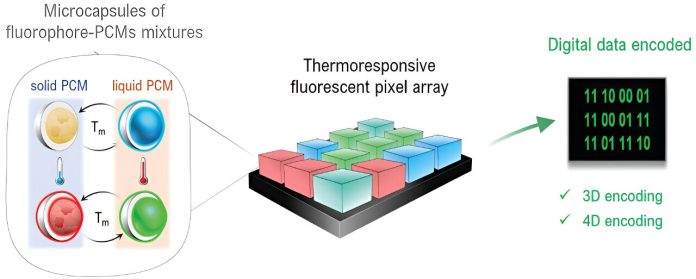
A team of scientists has developed a groundbreaking digital encoding and data storage system that could revolutionize areas like cybersecurity and anti-counterfeiting.
This new system uses tiny capsules filled with glowing dyes and materials that change with temperature to create a unique way of storing and encrypting data.
The research was conducted by Dr. Claudio Roscini and Prof. Daniel Ruiz-Molina from the ICN2 Nanostructured Functional Materials Group, along with their colleagues from the Autonomous University of Barcelona (UAB).
Their findings were published in the journal Advanced Functional Materials.
The system relies on tiny “pixels” made from microcapsules that contain a combination of fluorescent dyes and phase change materials, like paraffins.
These materials are known for their ability to absorb and release heat when the temperature changes.
In this new system, the researchers took advantage of this property to create a method of encoding data that is both cost-effective and easy to use.
Here’s how it works: The pixels can change color in response to changes in temperature or voltage. This color change allows the system to perform advanced data encoding operations in three and even four dimensions. For example, the position and color of the pixels provide three-dimensional (3D) data encoding, similar to how QR codes work. The fourth dimension comes into play with the material’s response to temperature, adding an extra layer of complexity to the data storage.
This innovative approach offers several potential applications, particularly in areas where secure and high-density data storage is crucial. The system’s ability to encode data in multiple dimensions makes it a powerful tool for preventing counterfeiting or storing large amounts of data in a small space.
Overall, this new digital encoding system is a significant step forward in data storage technology. By combining fluorescent dyes with phase-changing materials, the researchers have created a versatile and efficient way to encode and protect data.
This technology could soon provide low-cost, highly effective solutions for a range of industries, making digital information more secure and accessible.



